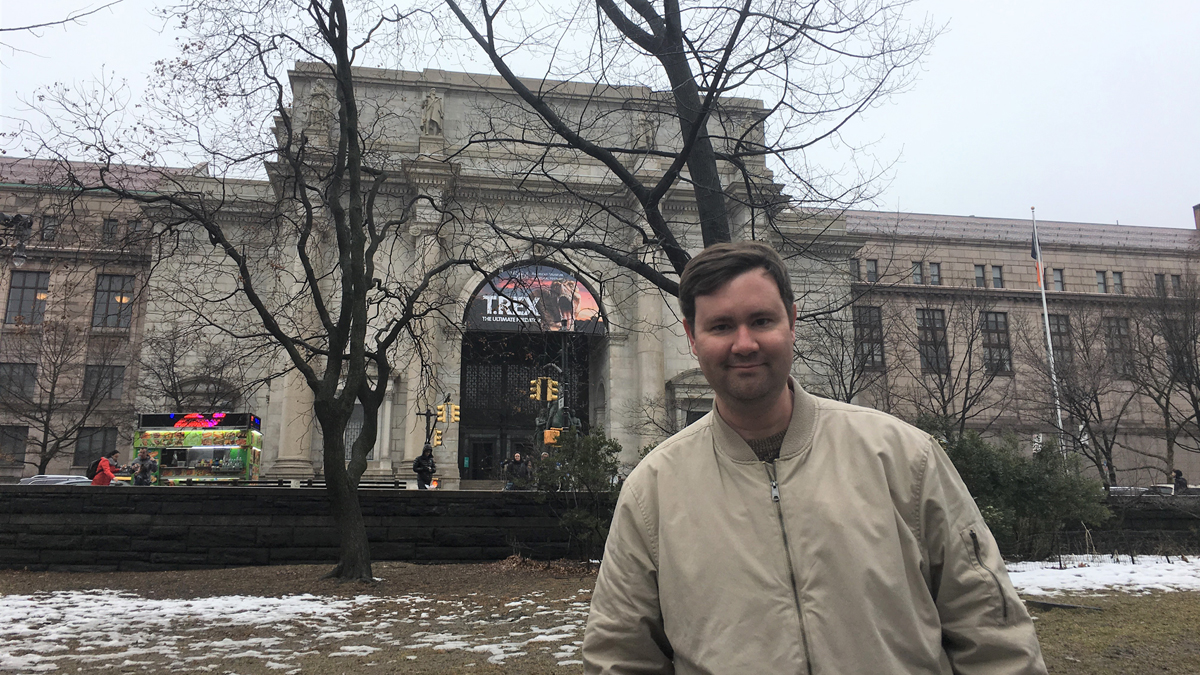
Daniel Hummer, a geology researcher at Southern Illinois University Carbondale, stands outside the American Museum of Natural History in New York City. The museum invited Hummer to design an exhibit that will tell the story of the original 12 minerals in the universe, and how they evolved into thousands over billions of years. The exhibit opens this month. (Photo provided)
June 23, 2021
SIU geology professor creates NYC museum exhibit on mineral evolution
CARBONDALE, Ill. — A geology researcher at Southern Illinois University Carbondale has quite a story to tell: the history of minerals in the universe.
And he is telling it at the American Museum of Natural History in New York City. Daniel Hummer’s exhibit, which went on display in June, recounts the history of the original 12 minerals in the universe and how they evolved into thousands over billions of years, a relatively new approach in the field.
Hummer, assistant professor in the School of Earth Systems and Sustainability at SIU, received the offer to design the exhibit late in 2018. As the lead designer of the project, he began working on it in 2019, with an original scheduled opening in summer 2020. But the COVID-19 pandemic delayed all of that.
The exhibit describes how key events in geologic history gave birth to new minerals. Some such events include the universe’s first supernovae, the formation of Earth, the development of plate tectonics, the origin of life and the development of photosynthesis.
One of the key messages in the exhibit is that the story of life and the story of minerals are interconnected in ways that researchers never previously imagined, Hummer said.
“Minerals may have played a role in creating life by allowing new interactions of molecules on their surfaces, and in turn, life alters the environment enough to allow the formation of new minerals,” Hummer said. “So the evolution of both life and minerals rely on each other in ways that we’re only beginning to understand. They are not separate systems. They are all parts of the same system that continually influence each other over Earth’s history.”
Since its founding 1869, the AMNH has become one of the world’s preeminent scientific and cultural institutions and is renowned for its exhibitions and scientific collections, which serve as a field guide to the world and present a panorama of its cultures. Hummer’s exhibit is in the museum’s Allison and Roberto Mignone Halls of Gems and Minerals.
The approach of mineral evolution, which looks at the way Earth minerals have changed over time instead of simply analyzing present-day content, was first proposed about a decade ago by Robert Hazen, Hummer’s former postdoctoral adviser.
“Since that time, we’ve discovered a great deal about how minerals have changed over time, but the field is still very much in its infancy,” he said.
The exhibit may be on display more than 20 years and is quite detailed and elaborate. For instance, the “anchor” graphic of the exhibit is a spiral timeline of the entire history of the universe. The earliest history begins in the center of the spiral in more compressed fashion, with the “big bang” in the middle and the more recent history expanded on the edges.
Each color-coded portion of the graphic represents a particular stage of mineral evolution, while each mineral evolution stage will be accompanied by an enlarged information box on the panel below. Each box will contain a title for the stage, a brief explanation and samples of representative minerals and/or rocks that formed during that stage.
The visual and video portions of the mineral evolution exhibit opened to the public this June. Those exhibits are on display in the newly renovated area of the museum.
Hummer said being approached by one of the world’s most prestigious museums to design an exhibit is a bit surreal and more than just a professional honor.
“It’s also an incredible opportunity to show parts of my research to the public, in a place and format where it can be viewed by millions of people,” he said. “I’ve always felt that science education and outreach is one of the keys to society’s future, and I’m excited to have a chance to show the general public how fascinating, and how important, the story of minerals is to life and to our planet as a whole.”
